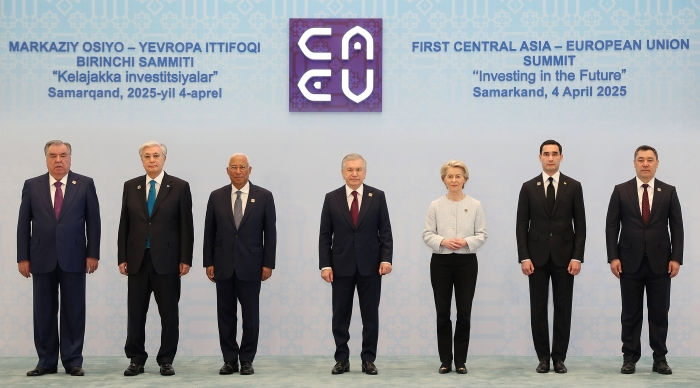EU-CA: More than a fling this time?
- Rashid
- 11 minutes ago
- 4 min read
The first-ever EU–Central Asia Summit took place in Samarkand on 4 April 2025—a historic setting for what might be a turning point in the region’s geopolitical balancing act. Could this signal the European Union finally stepping up as a credible, consistent alternative to the deep-rooted influence of Russia and the growing presence of China? In this blog post, I reflect on what the summit means, what was (and wasn’t) said, and what to pay attention to in the coming months.

To understand the significance of the EU–Central Asia Summit, we need to consider the shifting geopolitical landscape that led us here. For most of the post-Soviet period, Central Asia remained on the EU’s periphery—geographically and politically. While certain EU member states maintained bilateral ties with Kazakhstan, largely driven by energy interests, the broader EU approach remained hesitant and underdeveloped. Instead, the so-called “Western presence” in the region was dominated by the United States. But today, the U.S. is in retreat—adopting a more isolationist posture and even straining its relationships with long-standing partners in Europe.
Meanwhile, Russia has maintained a deeply entrenched presence in Central Asia through political influence, military alliances, economic ties, and a potent blend of soft power. China, on the other hand, has flooded the region with cash and infrastructure through its Belt and Road Initiative—investments that, in many cases, have contributed to significant debt burdens for Central Asian states.
Amid these global shifts, Central Asia itself has been undergoing a quiet transformation. In a move that seemed unthinkable just weeks ago, Presidents Mirziyoyev, Japarov, and Rakhmon stood together to unveil a “stele of eternal friendship,” claiming to have resolved longstanding border disputes. There is even talk of a unified Central Asian tourist visa—a very meaningful step toward regional integration.
In the wake of Russia’s full-scale invasion of Ukraine, many observers spoke of a window of opportunity for the EU to deepen its engagement with Central Asia. But in reality, it felt more like a small raam than an open window. The EU was—and in many ways still is—grappling with an identity crisis of its own, spurred by domestic shifts toward populism, nativism, and rising Euroscepticism. Disenchantment with democracy, once dismissed as an older generation’s nostalgia for simpler times, has begun to resonate with younger Europeans, particularly in the face of persistent economic uncertainty.
With the U.S. pulling back, the EU is now cautiously stepping in—but on pragmatic terms. The pitch to Central Asia centers on trade, transport, energy, climate, raw materials and digitalization. Topics like human rights and democracy weren’t on the agenda in Samarkand—and, to be fair, they’re increasingly absent from the agenda in Brussels too.
So, is the EU coming to Central Asia with a long-term partnership in mind, or is this just another geopolitical fling?
The interest—on both sides—seems to lean toward something more stable and sustainable. Central Asian autocrats are eager to diversify their portfolios and stop putting all their eggs in Moscow or Beijing’s baskets. But let’s not get ahead of ourselves.
There’s still a high chance that after smiling in a family photo with the EU, some leaders will be off to bow to the Tsar in Moscow on 9 May 2025. If they don’t make the pilgrimage this year, though, it might be a tangible sign that the winds really are shifting. Time will tell.
In the meantime, the priority for Central Asian states should be strengthening regional ties—not just for photo ops or symbolic statues, but through real, lived cooperation. For starters, how can we talk about integration when some regional capitals aren’t even connected by direct flights? When produce freezes at the border checks? Speaking from personal experience, it was easier for me to move from Uzbekistan to the Netherlands than to Kyrgyzstan. The movement of people, goods, and services remains clunky at best. That has to change. A tourist visa for foreigners is fine, but what’s really needed is genuine collaboration that benefits the people of each state in the region.
A decade ago, I might’ve said the EU was the ideal partner to support that vision. But today, with Euroscepticism on the rise within the EU and border checks creeping back between the Netherlands, Germany, and Belgium, that seems hypocritical.
Central Asia needs to focus on itself now. And frankly, there’s no better moment than this.
As for the EU, straying from its core values is a dangerous game. In certain domains—especially in rule of law, education, innovation, and governance—the EU has no real competitors. These strengths should be proudly showcased and made genuinely attractive to partners like Central Asia. Leaning into pragmatic deals while quietly sidelining democracy and human rights might seem convenient now, but it risks deepening the EU’s internal identity crisis. Positioning itself as a global player while compromising on its founding principles is not strategic—it’s self-defeating.
If the EU wants to be taken seriously on the world stage, it must act like the power it aspires to be: one that values, defends, and promotes democracy. Otherwise, what really sets it apart from Russia or China?
P.S. Having analyzed Russian media reactions to the Summit, three clear approaches emerge. First, some major outlets ignore the event altogether, as if it never happened. Second, others offer dry, minimal coverage—just enough to acknowledge it without giving it weight. Third, the usual propaganda machine kicks in, portraying Central Asian states as naïve children being lured by the seductive, evil serpent that is the EU—an illusion only Russia can dispel. Whichever narrative they choose, all three responses underline one thing: the summit mattered. And its timing couldn’t be more significant.


Comments